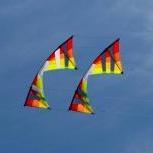I am curious what parts are you thinking of that would need 3D printing?
Angled connectors already exist in bulk at many angles and diameters, assorted end caps, nocks, stoppers, clips, dihedral and APA connections, and flexible fittings (made from rubber tubing or bent metal) are readily available. The connectors are solidly built. The same companies that make and distribute composite spars and rods used to have a color coded system for diameters. The color codes are mostly passed, but the wide variety of parts still exists.
Between the hardware stores and kite shops just about any angle or flexible fitting can be found or made by drilling.
I could see it for prototypes or if you do not want to pay shipping costs or wait for shipping times. As you described, most parts could be 3D printed if someone really wants to.
Do you know how they would compare in strength, stress, and pressure capabilities versus existing molded parts?

